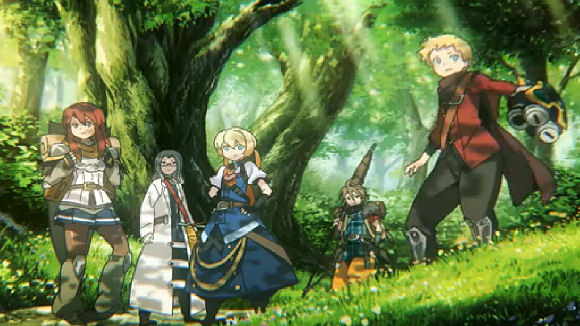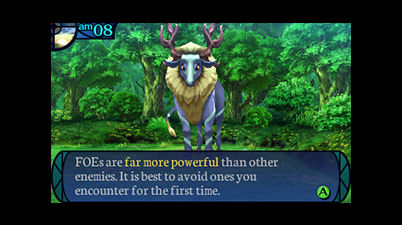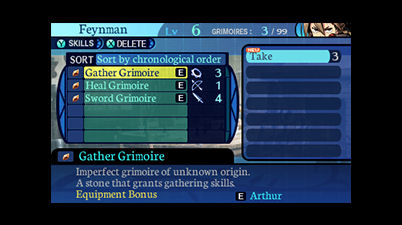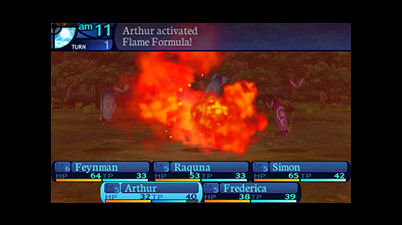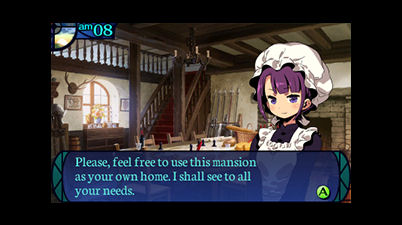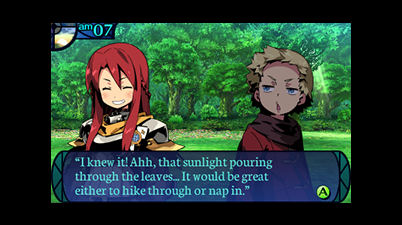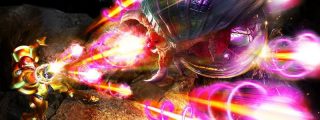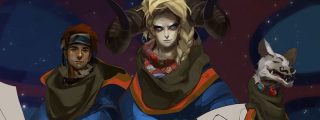Etrian Odyssey Untold: The Millennium Girl, the latest edition from the popular series for the DS and 3DS, released at the beginning of October. So why is this review coming out nearly a month after the fact? Because this seemingly simple title is a big game that required a complete and thorough play-through before I could give it a fair evaluation. What starts out as an almost by-the-numbers RPG has a surprising amount of depth which will surely please fans of the series and may have something to offer to new players, as well.
Probably most notable in this iteration of the series is the story mode, a first for Etrian Odyssey. In this story you play as a member of the Highlanders, a tribe of warriors who value “justice above all else”. You have been summoned to the town of Etria, a bustling metropolis which sits on top of the Yggdrasil Labyrinth, an ancient dungeon filled with monsters and valuable resources. You are tasked with investigating mysterious earthquakes and hostile monsters believed to be related to the Labyrinth and the technologically advanced ruins of an ancient civilization. Along with the aid of an investigative team from the prestigious Midgard Library and the titular Millennium Girl who has been cryogenically frozen for a thousand years, you will delve to the depths of the Labyrinth to solve these mysteries and save Etria from doom.
Fans of the series and other Atlus titles like Megami Tensei will recognize Etrian Odyssey’s gameplay style. The entirety of the game takes place through a first-person perspective, both as you visit locations in town and explore through the dungeon. Inside the Yggdrasil Labyrinth you will proceed tile by tile, facing random encounters and powerful mini-boss monsters called FOEs, mining valuable resources which can be sold in town and completing side-missions which generally involve tracking down specific locations or materials in the dungeon. What is unique to Etrian Odyssey is that you will be tasked with making your own map as your progress through the dungeon. The bottom screen of the 3DS always functions as a map and will automatically color tiles that you walk on, but you will be responsible for drawing walls, placing markers and leaving notes to help you navigate, and given the size and complexity of each level, you will definitely want your maps to be precise.
Etrian Odyssey is definitely comfortable being intended for a specific niche of players. Acting as your own cartographer is an intriguing idea, and the benefits of having good maps are innumerable, especially as you return to previous levels of the dungeon to complete side quests, but the actual process quickly grows tedious. The process of exploring new areas feels consistently interrupted as you stop every several steps to draw out your progress. To make matters worse, the scenery of an individual level looks almost exactly the same; the walls and floors of levels all look terribly similar with only minor variation, and as you are always looking through the first-person perspective you can only see what is directly in front of you. Because of this you will most likely spend more time looking at your map than you will the main screen. Where this becomes a major problem is if you should make a mistake on your map. More than once I found myself unable to figure out how to proceed through a level and losing large chunks of time only to find that somewhere along the line I had accidentally drawn a wall where there was in fact a passage I had yet to explore. I suspect that more meticulous players will take pride in their map making, but I found the whole process to be rather distracting and even my best efforts to keep proper maps still resulted in mistakes that lead to frustration.
On top of this, despite a lot of things happening within the first hour or so of play, the next five or six hours of this game are very slow. Your only real direction is to go deeper into the dungeon, which proceeds at a snail’s pace often requiring you to explore a part of a level and then return to town for healing and to empty your inventory three or four times per area. Not much else happens during this time; there are few interesting side quests to be had, the plot barely goes anywhere, and the game basically plays like one long grind that made me want to switch off the game out of boredom.
So with all these issues, is there any reason to play Etrian Odyssey if you aren’t already a fan? Well, surprisingly yes, there may be. But only if you can get through this game’s rough start.
At first glance, this game’s combat system appears to be rather underwhelming. You face monsters in first-person menu-based combat that would have felt stodgy on the SNES. But once you get your entire team assembled things begin to change. Your team will consist of some fairly familiar archetypes: The versatile fighter, the damage-sponge, the fragile healer, the magic user and the gun-wielding DPS role, but the way you use these characters’ skills can drastically affect the outcome of battles. While it’s true that most of the random encounters can be beaten by just relentless attacking, the tougher FOEs and bosses are almost impossible to beat with brute force alone. Effectively using each character’s special abilities in response to an enemy’s weaknesses are essential.
For example, many bosses possess one or more devastating attacks which can wipe out the party after a few uses, but often times these skills are linked to either their head, arms or legs. If you can identify the right target, you can use techniques to bind those appendages and deprive the monster of these abilities, often turning an unbeatable adversary into an easy win. Another example is that when defeated, monsters will drop resources that can be taken back to town to be sold and turned into new equipment. But some resources are only dropped when monsters are defeated in a certain manner, and these tend to produce the best new weapons and armor. Aspects like these do a lot to keep battles interesting and fresh.
In fact, there are a lot of little touches that make a big difference in this game and it works hard at keeping things varied. There are many examples of the way the game takes a relatively simple system and adds a surprising amount of depth and intricacy which I did not expect at first. At one point the characters establish a guild and receive a mansion complete with a maid who sees to their affairs. Building a good relation with this maid character unlocks recipes which she can prepare to give a buff to the party the next time they enter the dungeon; these buffs can do things like increase your maximum HP or grant healing and spell points per turn of combat and become incredibly useful as the game progresses.
Another way this games surprised me is in how far it goes to eliminate frustrations from the experience. For example, while the game is not particularly difficult, it is always a possibility that a battle won’t go your way and your party will die. This spells game over and requires you to reload your last save, however, the game will offer to save your map data, meaning that any progress you have made in mapping the dungeon will be saved and you will be spared the laborious task of doing it again. There are quite a few examples like this, so much so that throughout the game I found myself frequently surprised at how far the developers had gone to ensure that I don’t find myself repeating pointless tasks.
And while that’s all well and good, it’s not going to make a difference if the game doesn’t go anywhere, right? Indeed, but things do pick up in Etrian Odyssey. What starts out as an almost mindless dungeon crawl begins to materialize into a pretty solid RPG if you can be patient. The story hasn’t broken the mold in terms of being new or creative, in fact I would say it’s pretty familiar. Because of that familiarity I found myself experiencing a sense of nostalgia for classic era JRPGs, and that in and of itself was surprisingly enjoyable.
This game enjoys a truly loving translation and I feel that whoever did the localization went above and beyond in their duty. The dialogue reads not only as natural, but clever and even eloquent at times. Indeed, a lot of the game’s charm comes from the warmth, humor and excitement conveyed by thoroughly well-written text. While there is the occasional oddly-worded conversation or situation that simply didn’t seem to translate well, by and large Etrian Odyssey flows in a way that many other games would be jealous of.
It should be noted that I only completed the game in Story Mode. The game also has the option to play in Classic Mode which allows you to create your own party members, mixing and matching classes and generally giving the player more freedom in how they run the game. While Classic Mode does follow the same plot as Story Mode it doesn’t have the additional plot elements of predetermined characters, and I feel like it would have made the game far less interesting if the relentless dungeon crawling wasn’t occasionally broken up with the additional scenes of dialogue.
I’ve rarely played a game that took me through such a roller coaster ride of opinions. I began the game rather indifferent to the concept as a whole, and then became rather irritated with the slogging nature of the initial five or six levels of dungeons. But after a rather tumultuous start the game hits a surprising stride in terms of parsing out progress, plot-development and new challenges in increments that make things rather exciting. While at first the game feels like a rather long campaign just to get to the bottom of the labyrinth, as it picks up with additional side quests and opportunities to interact with and learn more about the characters and the world they inhabit it really starts to take off and become an enjoyable experience. The game does, however, carry on just a bit longer than I would have cared for; I think I got about 45 to 50 hours of gameplay from this title, but probably would have been happier if it were a little more succinct.
In the end I struggled with what kind of score to give this game. To call it average seemed unfair to all the ways that this game succeeds both in its niche genre and as overall enjoyable RPG experience. Yet, to call it great in spite of its terribly slow start and limited appeal to players who aren’t fans of dungeon-crawling didn’t seem quite right either. In the end I feel that the game’s merits outweighs its issues. For gamers who are fans of this series or games like it I would go so far as to give it a full 5 out 5, but even for the rest of us Etrian Odyssey Untold: The Millenium Girl is still a pretty good gaming experience and I think that curious players will find something to enjoy here.


